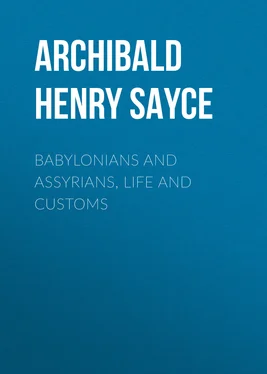Archibald Henry Sayce - Babylonians and Assyrians, Life and Customs
Здесь есть возможность читать онлайн «Archibald Henry Sayce - Babylonians and Assyrians, Life and Customs» — ознакомительный отрывок электронной книги совершенно бесплатно, а после прочтения отрывка купить полную версию. В некоторых случаях можно слушать аудио, скачать через торрент в формате fb2 и присутствует краткое содержание. Жанр: foreign_prose, История, foreign_edu, foreign_antique, на английском языке. Описание произведения, (предисловие) а так же отзывы посетителей доступны на портале библиотеки ЛибКат.
- Название:Babylonians and Assyrians, Life and Customs
- Автор:
- Жанр:
- Год:неизвестен
- ISBN:нет данных
- Рейтинг книги:5 / 5. Голосов: 1
-
Избранное:Добавить в избранное
- Отзывы:
-
Ваша оценка:
- 100
- 1
- 2
- 3
- 4
- 5
Babylonians and Assyrians, Life and Customs: краткое содержание, описание и аннотация
Предлагаем к чтению аннотацию, описание, краткое содержание или предисловие (зависит от того, что написал сам автор книги «Babylonians and Assyrians, Life and Customs»). Если вы не нашли необходимую информацию о книге — напишите в комментариях, мы постараемся отыскать её.
Babylonians and Assyrians, Life and Customs — читать онлайн ознакомительный отрывок
Ниже представлен текст книги, разбитый по страницам. Система сохранения места последней прочитанной страницы, позволяет с удобством читать онлайн бесплатно книгу «Babylonians and Assyrians, Life and Customs», без необходимости каждый раз заново искать на чём Вы остановились. Поставьте закладку, и сможете в любой момент перейти на страницу, на которой закончили чтение.
Интервал:
Закладка:
It would seem that she was on a level with him also in the eyes of religion. There were priestesses in Babylonia as well as priests. The oracles of Istar at Arbela were worked by inspired prophetesses, who thus resembled Deborah and Huldah and the other prophetesses of Israel. When Esar-haddon inquired of the will of heaven, it was from the prophetesses of Istar that he received encouragement and a promise of victory. From the earliest period, moreover, there were women who lived like nuns, unmarried and devoted to the service of the Sun-god. The office was held in high honor, one of the daughters of King Ammi-Zadok, the fourth successor of Khammurabi or Amraphel, being a devotee of the god. In the reign of the same king we find two of these devotees and their nieces letting for a year nine feddans or acres of ground in the district in which the “Amorites” of Canaan were settled. This was done “by command of the high-priest Sar-ilu,” a name in which Mr. Pinches suggests that we should see that of Israel. The women were to receive a shekel of silver, or three shillings, “the produce of the field,” by way of rent, while six measures of corn on every ten feddans were to be set apart for the Sun-god himself. In the previous reign a house had been let at an annual rent of two shekels which was the joint property of a devotee of the Sun-god Samas and her brother. It is clear that consecration to the service of the deity did not prevent the “nun” from owning and enjoying property.
Like Samas, the Sun-god, Istar was also served by women, who, however, do not seem to have led the same reputable lives. They were divided into two classes, one of which was called the “Wailers,” from the lamentations with which each year they mourned the death of the god Tammuz, the stricken favorite of Istar. The Chaldean Epic of Gilgames speaks of the “troops” of them that were gathered together in the city of Erech. Here Istar had her temple along with her father, Anu, the Sky-god, and here accordingly her devotees were assembled. Like the goddess they served, it would appear that they were never married in lawful wedlock. But they nevertheless formed a corporation, like the corporations of the priests.
Babylonian law and custom prevailed also in Assyria. So far as can be gathered from the contracts that have come down to us, the Assyrian women enjoyed almost as many privileges as their sisters in Babylonia. Thus, in 668 B.C., we find a lady, Tsarpî by name, buying the sister of a man whose slave she was, for reasons unknown to us, and paying half a maneh of silver (£4 10s.) for the girl. Tsarpî was a “prefectess,” like another lady who is called “the prefectess of Nineveh,” and who, in 683 B.C., purchased seventeen slaves and a garden. It is plain from this that women could hold civil offices and even act as governors of a city.
In fact, wherever Babylonian culture and law extended, the principles and practice of it were necessarily in force. The Amorite colonies from Canaan established in Babylonia for the purposes of trade in the age of Abraham were naturally subject to the Babylonian laws, and the women among them possessed all the rights of their Babylonian neighbors. At the very beginning of the dynasty to which Khammurabi belonged, an Amorite lady, a certain Kuryatum, brought an action for the recovery of a field which had been the property of her father, Asalia, and won her suit. Kuryatum and her brother were themselves subsequently sued by three other “Amorites,” the children of Izi-idrê, one of whom was a woman, for a field and house, together with some slaves and palm-trees, of which, it was asserted, they had wrongfully taken possession. The judges, however, after hearing both sides, dismissed the case.
It is not strange that the same laws and principles should have held good in Canaan itself, which was so long a Babylonian province. Sarah, who was of Babylonian origin, owned a female slave (Gen. xvi. 2, 6, 8, 9), and the Kennizzite Caleb assigned a field with springs to his daughter Achsah in the early days of the invasion of Canaan (Josh. xv. 18, 19). A Canaanitish lady takes part in the Tel-el-Amarna correspondence, and writes to the Pharaoh on matters of state, while the Mosaic Law allowed the daughter to inherit the possessions of her father (Numb. xxxvi. 8). This, however, was only the case where there was no son; after the Israelitish conquest of Canaan, when the traditions of Babylonian custom had passed away, we hear no more of brothers and sisters sharing together the inheritance of their father, or of a wife bequeathing anything which belongs to her of right. As regards the woman, the law of Israel, after the settlement in Canaan, was the moral law of the Semitic tribes. We must go back to the age of Abraham and Sarah to find a Hebrew woman possessed of the same powers as the Babylonian lady who, in the fifth year of Cambyses, sold a slave for two manehs and five shekels of silver, her husband and mother guaranteeing the value of the chattel that was thus sold.
The dowry which the woman brought with her on marriage secured of itself her independence. It was her absolute property, and she could leave it by will as she pleased. It protected her from tyrannical conduct on the part of her husband, as well as from the fear of divorce on insufficient grounds. If a divorce took place the dowry had to be restored to her in full, and she then returned to her father's house or set up an establishment of her own. Where no dowry had been brought by the bride, the husband was often required by the marriage contract to pay her a specified sum of money in case of her divorce. Thus a marriage contract made in Babylon in the thirteenth year of Nebuchadnezzar stipulates that, if the husband marries a second wife, the act shall be equivalent to a divorce of the first wife, who shall accordingly receive not only her dowry, but a maneh of silver as well. The payment, in fact, was a penalty on the unfaithfulness of the husband and served as a check upon both divorce and polygamy.
The dowry consisted not of money alone, but also of slaves and furniture, the value of which was stated in the marriage contract. In the contract just referred to, for instance, part of the dowry consisted of a slave who was valued at half a maneh. Sometimes the dowry included cattle and sheep. In the sixth year of Nabonidos we hear of three slaves and “furniture with which to stock the house,” besides a maneh of silver (£6), being given as the marriage-portion. In this instance, however, the silver was not forthcoming on the wedding-day, and in place of it a slave valued at two-thirds of a maneh was accepted, the remaining third being left for payment at a subsequent date. Where the dowry could not be paid at once, security for the payment of it was taken by the bridegroom.
The payment was made, not by the bridegroom, as among the Israelites and other Semitic peoples, but by the father of the bride. If he were dead, or if the mother of the bride had been divorced and was in the enjoyment of her own property, the mother took the place of the father and was expected to provide the dowry. In such a case she also naturally gave permission for the marriage, and it was from her accordingly that consent to it had to be obtained. In one instance, however, in a deed dated in the sixteenth year of Nabonidos, a sister is given in marriage by her two brothers, who consequently furnish the dowry, consisting of a piece of ground inherited from the mother, a slave, clothes, and furniture. It is evident that in this case both the parents must have been dead.
It was the bridegroom's duty and interest to see that the dowry was duly paid. He enjoyed the usufruct of it during his life, and not unfrequently it was employed not only to furnish the house of the newly married couple, but also to start them in business. It was with his wife's dowry that Ben-Hadad-nathan bought in part the house to which his widow laid claim after his death, and we read of instances in which the husband and wife enter into partnership in order to trade with the wife's money. More frequently the wife uses her dowry to transact business separately, her purchases and loans being made in her own name; this is especially the case if she otherwise has property of her own. 2 2 In certain cases the wife seems to have had the power of claiming alimony from her husband, though we do not know what were the circumstances which were held sufficient to justify the claim. Thus, in the third year of Nabonidos, “Nahid-Merodach, the son of Samas-baladhu-iqbi, voluntarily granted his wife Ramûa and his son Arad-Bunene four qas of food and three qas of beer daily, as well as fifteen manehs of wool, one pi of sesame, one pi of salt, and sixty qas of sweetmeats each year,” with the provision that the grant should never be cancelled or willed away. The son, however, is included in the gift, and it is possible, therefore, that Ramûa was little more than a concubine.
Интервал:
Закладка:
Похожие книги на «Babylonians and Assyrians, Life and Customs»
Представляем Вашему вниманию похожие книги на «Babylonians and Assyrians, Life and Customs» списком для выбора. Мы отобрали схожую по названию и смыслу литературу в надежде предоставить читателям больше вариантов отыскать новые, интересные, ещё непрочитанные произведения.
Обсуждение, отзывы о книге «Babylonians and Assyrians, Life and Customs» и просто собственные мнения читателей. Оставьте ваши комментарии, напишите, что Вы думаете о произведении, его смысле или главных героях. Укажите что конкретно понравилось, а что нет, и почему Вы так считаете.












